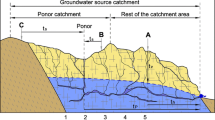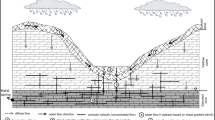Abstract
Karst aquifers represent important water resources in many parts of the world. Unfortunately, karst aquifers are characterised by high contamination risks. This paper presents a travel time based method for the estimation of karst groundwater vulnerability. It considers (1) physics-based lateral flow within the uppermost weathered zone (epikarst) in a limestone-dominated region and (2) high velocities of vertical infiltration at discrete infiltration points (e.g. sinkholes) or lines (e.g. dry valleys, faults). Consequently, the Transit Time Method honours the actual flow path within the unsaturated zone of a karst aquifer system. A test site in Northern Jordan was chosen for the demonstration of the assessment technique, i.e. the catchment area of the Qunayyah Spring north of the capital Amman. The results demonstrate that zones of highest vulnerability lie within valleys and nearby main fault zones. It also reveals that regions, categorised as protected areas by other methods due to thick unsaturated zones, contribute to a major degree to the total risk.










Similar content being viewed by others
References
Aller L, Bennet T, Lehr JH, Petty RJ (1987) DRASTIC: a standardized system for evaluating ground water pollution potential using hydrogeological settings. US Environmental Protection Agency Report, EPA-600/2-87-035, p 622
Brosig K (2005) Groundwater vulnerability mapping in the Qunayyah Spring catchment area (Jordan). Diploma thesis, University of Göttingen, Göttingen, p 194 (unpubl.)
Civita M, De Maio M (1997) SINTACS—Un sistema parametrico per la valutazione e la cartografia della vulnerabilità degli acquiferi all’inquinamento. Metodologia & automatizzazione (SINTACS—a parametrical system for assessment and vulnerability mapping of aquifer pollution). Collana “Quaderni di Tecniche di Protezione Ambientale”, n. 60, p 208
Daly D, Drew D (1998) The role of karst and karst vulnerability in the Irish groundwater protection scheme. Vulnérabilité et protection des eaux karstiques, Workshop 18.20. Mai 1998, Neuchâtel, p 4
Doerfliger N (1996) Advances in karst groundwater protection strategy using artificial tracer tests analysis and multiattribute vulnerability mapping (EPIK Method). PhD thesis Univ. Neuchâtel, p 308 (unpubl.)
Dunne S (2003) Vulnerability mapping for the protection of UK karst aquifers. PhD thesis Geography Dept., Trinity College Dublin
Ford DC, Williams PW (1996) Karst geomorphology and hydrology. Chapman & Hall, London, p.601
Goldscheider N, Klute M, Sturm S, Hötzl H (2000) The PI method–a GIS-based approach to mapping groundwater vulnerability with special consideration of karst aquifers. Zeitschrift für Angew Geol 46(3):157–166
GSI (1999) Groundwater protection schemes. Dept. of the Environmental and Local Government, Environmental Protection Agency and Geological Survey of Ireland, Dublin, p 24
Hölting B, Haertle T, Hohberger KH, Nachtigall KH, Villinger E, Weinzierl W, Wrobel JP (1995) Konzept zur Ermittlung der Schutzfunktion der Grundwasserüberdeckung (Concept of protection assessment of the groundwater cover). Geologisches Jahrbuch, C63, Hannover, pp 5–24
Jeannin PY (1996) Structure et comportement hydraulique des aquifères karstiques (Structure and hydraulic behaviour of karst aquifers). Neuchâtel, p 237
Jeannin PY, Corbaton F, Zwahlen F, Perrochet P (2001) VULK—a tool for intrinsic vulnerability assessment and validation. 7th Conference on Limestone Hydrology and Fissured Media, Besancon 20–22 Sep. 2001, Sci. Tech. Envir., Mém. H. S., no. 13, pp 185–190
Kralik M (2001) Spring dynamics as a tool to evaluate groundwater vulnerability. 7th Conference on Limestone Hydrology and Fissured Media, Besancon 20–22 Sep. 2001, Sci. Tech. Envir., Mém. H. S., no. 13, pp 215–218
Laimer HJ (2005) Die Erfassung der Karstgrundwasser-Vulnerabilität mit der Methode “VURAAS” (Karst groundwater vulnerability assessment with the “VURAAS” method). Springer, Grundwasser, pp 167–176
Maidment DR (ed.) (2002) Arc Hydro: GIS for water resources with CDROM. ESRI Press, Redlands, p 220
Malik P, and Svasta J (1999) REKS—an alternative method of karst groundwater vulnerability estimation. Hydrogeology and Land Use Management, Proceedings of the XXIX Congress of the International Association of Hydrogeologists, Bratislava, 79–85, September 1999
Mangin A (1975) Contribution à l’étude hydrodynamique des aquiféres karstiques (Contributions to the hydrodynamics of karst aquifers). Thèse, Université de Dijon, p 124
Margat J (1968) Vulnérabilité des nappes d’eau souterraine à la pollution (Aquifer vulnerability). BRGM-Publication 68, SGL 198, HYD, Orléans
Perrin J, Jeannin PY, Zwahlen F (2003) Epikarst storage in a karst aquifer: a conceptual model based on isotopic data, Milandre test site, Switzerland. J Hydrol 279:106–124
Pollock DW (1994) User’s Guide for MODPATH/MODPATH-PLOT, Version 3: A particle tracking post-processing package for MODFLOW, the U.S. Geological Survey finite-difference ground-water flow model. U.S. Geological Survey Open-File Report 94–464, p 234
Smart PL, Friederich H (1986) Water movement and storage in the unsaturated zone of a maturely karstified carbonate aquifer, Mendip Hills, England. In: D. National Water Well Association, Ohio (ed) Proceedings of the Conference on Environmental Problems in Karst Terranes and their Solutions, pp 59–87
Vías J, Andreo B, Perles MJ, Carrasco F, Vadillo I, Jiménez P (2002) Preliminar proposal of a method for vulnerability mapping in carbonate aquifers. In: Carrasco F, Durán JJ, Andreo B (eds) Karst and environment, pp 75–83
Vrba J, Zaparozec A (eds) (1994) Guidebook on mapping groundwater vulnerability. International contributions to hydrogeology (IAH), 16, Hannover, p 131
Williams PW (1983) The role of the subcutaneous zone in karst hydrology. In: Back W and LaMoreaux PE (Guest-Editors) V.T. Spingfield symposium—processes in karst hydrology. J Hydrol 61:45–67
Zötl JG (1974) Karsthydrogeologie (Karsthydrogeology). Springer, Wien, p 291
Zwahlen F (2004) (Chairman, Editor in Chief) COST Action 620—Vulnerability and risk mapping for the protection of carbonate (Karst) aquifers. Final Report
Acknowledgments
We like to thank Dietrich Helmcke (posthumously), Volker Steinbach (BGR), Armin Margane (BGR), Mathias Toll, Heike Werz, Klaus Heppe, Till Heinrichs, Mathias Röhring, Ayman Jaber, Hani Hijazi, Mazen Rayyan, Nidal Khalifa, Saleh Al-Ouran, Zakaria Haj-Ali, Randolf Rausch, Klaus Jacobi, and William Al-Khoury for assistance in the field with logistics and administrative matters, provision of data, and helpful and constructive discussions.
Author information
Authors and Affiliations
Corresponding author
Rights and permissions
About this article
Cite this article
Brosig, K., Geyer, T., Subah, A. et al. Travel time based approach for the assessment of vulnerability of karst groundwater: the Transit Time Method. Environ Geol 54, 905–911 (2008). https://doi.org/10.1007/s00254-007-0898-0
Received:
Accepted:
Published:
Issue Date:
DOI: https://doi.org/10.1007/s00254-007-0898-0




